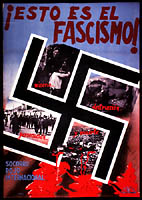 |
¡Esto es el fascismo! miseria... destrucción... persecución... y muerte
[This is fascism! Misery, destruction, persecution and death]. Socorro Rojo Internacional. Signed: Padial. Socorro Rojo de España, Comisión de Propaganda. Lit. S. Dura Socializada, U.G.T. C.N.T. Valencia. Photographic print and lithograph, 4 colors; 100 x 71 cm.
|
|
This poster was issued
by Socorro Rojo Internacional. Established in Spain in 1934,
SRI was one of the many international organizations that provided
essential services and supplies to war-torn nations. A powerful
denunciation of the fascists in Spain, this poster illustrates the
agenda of the Russian-dominated Communists who wanted to support
the Spanish Loyalists without appearing revolutionary. Fearing the
increasing threat of Germany under Hitler, Stalin did not want to
alienate democratic nations like England, France and the United
States by helping to stage a revolution in Spain. Rather, Stalin
hoped to use the Spanish Civil War to show these countries exactly
what fascism meant, with the expectation that they would quickly
become his allies in the international battle against the extreme
right.
In this poster, the elements
of fascism are reduced to their most basic and brutal level. The
image is organized around an imposing black swastika. In the top
left quadrant of the swastika, a photograph of a poor mother trying
to soothe her crying children is placed under the heading "misery."
The portrayal of woman in her role as mother is a tragic image that
was commonly used in loyalist propaganda. The quadrant directly
to the right deals with the "destruction" caused by the
rebels. As the photograph of statues reduced to rubble suggests,
the massive aerial bombardment during the war damaged a number of
Spain's monuments, despite efforts to protect them. A common accusation
made by the Loyalists was that rebel troops intentionally bombed
some of Spain's most valued treasures, such as the Prado Museum
and the National Library. The last two sections of the poster refer
to the tremendous injury and loss of life experienced during the
war. The "persecution" of prisoners who are being marched
down the street with raised arms and the "death" of Spaniards
whose blood flows on the cobblestone street alludes to the tragic
ending of the fascist nightmare. By utilizing rivers of blood that
gush from dead bodies and form pools at the bottom of the poster,
the artist emphasizes the physical suffering caused by Fascism.
The caption at the top of the poster, composed of brush strokes
that seem to have been dipped in blood, states simply the artist's
message: "This is Fascism!"
By incorporating actual
photographs from the war, Antonio López Padial, the artist
who designed this poster, created a powerful anti-Fascist image.
Little is known about Padial except that he worked for Socorro
Rojo Internacional during the war.
|




